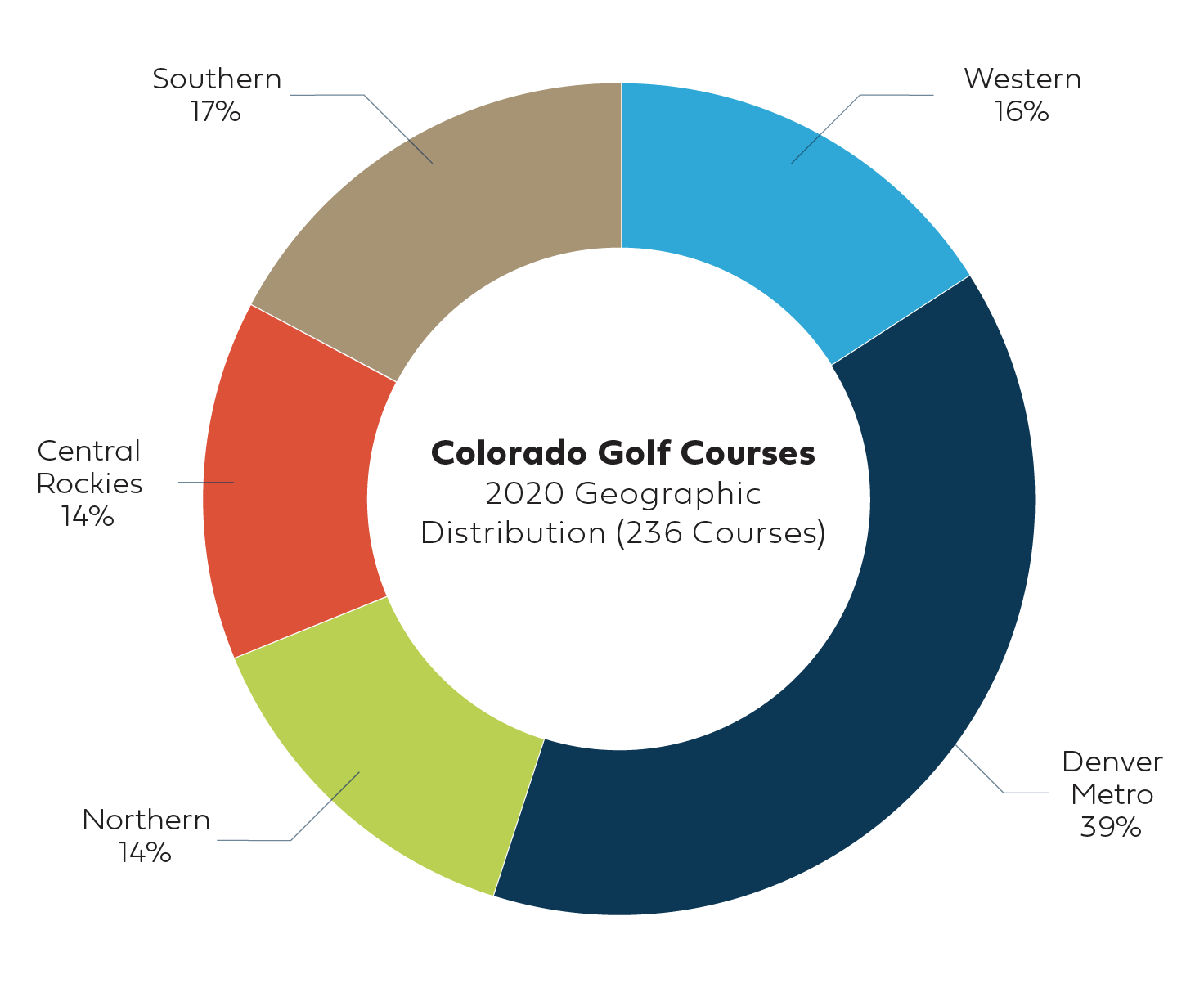Environmental Summary
Colorado golf provides 33,061 acres of greenspace with 236 golf courses across the state. It creates an economic revenue contribution of approximately $38,716 per golf course acre for the state of Colorado. Courses are located within five geographic regions: Denver Metro (93); Central Rockies (33); Northern (32); Southern (40); and Western (38).
The number of Colorado golf courses remains largely unchanged from 239 courses in 2002.
There are 21,206 acres of maintained turfgrass which was reduced to 64.1% of total golf course acreage vs. 67% in 2002; this includes Greens, Tees, Fairways and Rough.
Water, wetlands, and native rough comprise 36% of the acreage on Colorado golf courses totaling 11,855 acres which support wildlife habitats.
1,304 acres (nearly 4% of total golf course acreage) are designated wetlands and dedicated to wildlife habitat.
Greens, tees, and fairways account for 23.5% of total golf course acreage.
Turfgrass Reduction
There are 21,206 acres of maintained turfgrass which was reduced to 64.1% of total golf course acreage vs. 67% in 2002; this includes Greens, Tees, Fairways and Rough.
Greenspace, Ecosystem Services, Quality of Life
Colorado golf provides 33,061 acres of greenspace that supports wildlife habitats, reduces the urban heat island effect, filters surface water runoff, and contributes to the overall health and well-being of community members. The “green infrastructure” of Colorado golf courses includes turfgrass, native rough, water bodies, and wetlands to help offset the need and cost of public infrastructure required to store and manage stormwater.
Turfgrass Cooling Effect
Urban golf courses help cool cities; impervious surfaces in Denver are projected to increase from 49% in 2019 to 57% in 2020 and 67% by 2040, based on 2018 and 2019 reports from Denver Public Works.
Golf courses provide nearly five miles of exercise from walking an 18-hole course; increased physical activity supports health, prevention, and well-being to reduce risk of chronic disease and associated medical costs.
Golf maintenance BMPs are utilized during planning, design, construction, and ongoing operations to protect and encourage natural, flourishing wildlife habitats, nesting sites, and wildlife corridors.
Turfgrass, landscaping, and trees on golf courses remove air pollutants that can endanger human health.
Water Use & Conservation
In 2018, water use for Colorado golf courses was 41,213 acre-feet (AF), representing less than 1% of the state’s annual water consumption.
Total water usage for Colorado golf courses was comprised of 54.2% surface water, 27.3% reclaimed, 14.2% ground water/well self-supplied, 2.8% other and 1.4% from municipal sources.
This equates to an economic contribution for the state of Colorado of approximately $31,058 per AF of water used by Colorado golf courses.
There was 40,577 AF of irrigation water used, representing 98% of total water usage. This compares to 39,703 AF in 2002 the CGC report and 56,296 AF reported in the USGS report covering 2005.
Energy Conservation
More than half (56%) of Colorado golf course facility respondents have at least five or more energy conservation measures in place and 100% of respondents have implemented two or more.
Top 3 energy conservation efforts:
Variable Frequency Drives (VFDs) in pump stations (99%)
Indoor and outdoor LED lighting (92%)
Scheduling for HVAC and lighting (61%)
Waste Management & Recycling
The waste diversion rate for Colorado golf courses was 55.8% in 2018, trending higher than the 2018 waste diversion rate of 17.2% for the state of Colorado, and the national waste diversion rate of 35.2% in 2017.
Nearly all golf courses surveyed (97%) have at least two or more waste reduction measures in place with 61% having four or more, including recycling plastic, metal, glass, and electronics.
Colorado Golf Industry Environmental Impact Alignment to SDGs










